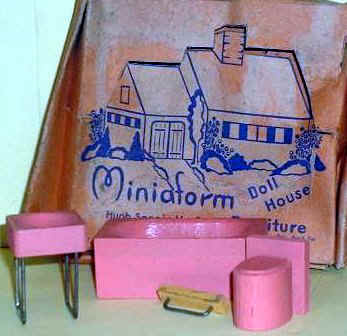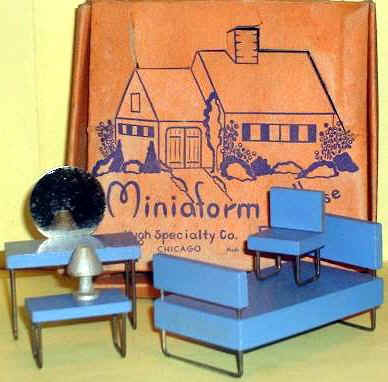|
1890s 1900-1920 part 2: 1920s part 2: late 1920s part 1: 1930s part 2: 1930s 1950s part 1: 1960-1990 part 2: 1960-1990 The decade of the 1940s is a watershed one for dollhouses and furnishings. The situation would never again be the same thanks to the introduction of new materials such as plastic, which was so amenable to mass production. Although one could argue that the Second World War (1939-1945) set back production for seemingly trivial items such as toys and with a scarcity of materials, it also reinforced the perceived need for new inventions and distribution systems. The full benefit of these was inherited during the decade of the 1950s, coinciding with an economic boom in North America. After the war, the United States -- its mainland unscathed by the destruction of combat -- took off as the leader in toy production to the point of needing to delegate production to occupied countries like Japan and Germany or counties with underpaid labourers such as Mexico. While traditional dollhouse materials continued to be used, particularly during the 1940s such as: cardboard and fibre-board with paper coverings imitating shingles, clapboarding, brick and interior decorative details; wood; and cast iron or soft-metal alloys, the era of steel houses and plastic furniture was here to stay. Some long-standing manufacturers of iron toys changed their products to support the war effort such as Hubley of Lancaster, Pennsylvania and Kilgore of Westerville, Ohio. Steel houses, which began to appear in the late 1940s, will be considered in this history in the decade of the 1950s. Another consideration in the 1940s is the tendency for the cheaper lines of wood furniture to compromise in detailing and quality making the products of the 1930s look more sophisticated by comparison.
left: wedding picture, 1941, Lancaster, Ontario Canadaİ right: couple and furnishings from the 1940s; husband in shirt and tie, double-breasted suit with pant cuffs and wide lapels and leather shoes; wife in tailored suit just below the knees and detailing at the neck, nylons and fancy shoes; made from some kind of hard black rubber-like material, manufacturer not yet identified but likely American. photo, J.McKendryİ
In North American architecture, the Colonial Revival style was firmly established. It had been introduced much earlier and lasted much longer but the 1940s embraced it -- perhaps because of its comforting familiarity in a world ripped apart by conflict and caught in the whirlwind of technological change. Whole cities in Germany disappeared in raging fires from conventional air bombing and then in Japan through the devastation of the atomic bomb. "Colonial" roused a sense of patriotism as it was, according to a description of 1928, "more closely associated with American history and traditions than any other type of architecture (O'Dell, Home Builder's Catalogue)." "Colonial" in the United States referred to the British-influenced styles previous to the War of Independence, especially in the 18th century, and "Georgian Revival" in Canada to the styles of the late 18th and early 19th centuries. Americans took an interest in this aspect after the nation's Centennial in 1876 with architectural firms such as McKim, Mead & White catering to a wealthy clientele along the Eastern Seaboard. Classical planning, forms and ornament were reinforced during the courses taught at the Ecole des Beaux Arts in Paris, the mecca of North American architects and artists in training at the turn of the 20th century. Homes for the middle class and homes for the dolls of middle-class children were much freer about the niceties of classicism for example opting to break symmetry when convenient.
A home-made dollhouse from Whitby, Ontario, Canada, skilfully made from plywood and fibreboard (on the roof), recently repainted and panes and dividing bars added to the windows. Such houses are difficult to date but the "Colonial" style is reminiscent of the '40s with a lingering remnant of Tudor half-timbering in the gable ends. There are 8 rooms arranged around an upper and a lower centre halls, which are only accessible by the front and back doors, interior doorways and a large upper window. In an unusual arrangement, the rooms are open on the end walls. The large attic is not accessible. Some of the charming original wallpaper with silver flying birds (right) and paint colours were revealed when inappropriate large-scale 1960s wallpapers and shag carpeting were removed. photo, J.McKendryİ
The design for some home-made dollhouses may have originated on the pages of magazines such as this one for "a charming little Cape Cod" in the December 1939 issue of Popular Mechanics. Father's secret efforts in the workshop, while following the directions given via plans and elevations, result in a dollhouse on Christmas morning for his daughter. There are enough dollhouses lacking finishing details, especially in the interiors to suggest Dad ran out of time or patience. The basic house was good enough. photo, J.McKendryİ
The advertisements above for RICH factory-made Colonial dollhouses are from the November 1947 Children's Activities magazine, and the one on the right from The Toy Yearbook, 1946-47. photo, J.McKendryİ Fibreboard and "U.S. Gypsum hardboard" are covered in attractive imitation tiles, clapboarding, landscaping, shutters and windows, although the more expensive model featured swinging windows with metal frames and plastic panes. The four columns on the porch of that house suggest Colonial houses of the American south. The green shutters (left) have a cut-out pine tree in the top panel similar to the real houses shown in the O'Dell pattern book and on the Kingston house illustrated further above. The Rich Company of Iowa made dollhouses in the 1930s into the early 1960s.
Because of the use of contemporary styles, the Keystone tiny houses made from solid pieces of wood are interesting and originally were grouped in village sets (above: front and back of the same Colonial house -- a tree typically is nailed to the middle of the back wall). Collectors today may be tempted to place such a house (which is 3½ inches long) in the playroom of a 1:12 or 1:16 scale 1940s dollhouse, as if it was a dollhouse for the children. To dress up a Keystone village in the form of cars, trucks, people, animals, trees, etc., one can use modern reproductions of 1940s and '50s items in the N scale made for train collectors. photo, J.McKendryİ
photo, J.McKendryİ
Plastic furniture made by Ideal and Renwal suits this sort of house well. Here it is mainly furnished by Reliable of Toronto, Canada and inhabited by a family made by the American firm Renwal. Although these manufacturers began in the second half of the 1940s, their popularity in the 1950s has caused them to be discussed in this history in that decade. The 1940s saw the continued success one of America's the established makers of wooden furniture -- Strombecker -- discussed in the 1930s part 2. That company produced a range of qualities of dollhouse furnishings, whereas a number of successful American companies in the 1940s seemed to concentrate on a cheaper line of wooden furniture, usually characterized by drawers and doors that do not open and are represented by incised lines. Perhaps the economic pinch of the war discouraged customers from freely spending money on play things.
One of Nancy Forbes' competitors was DONNA LEE (Woodburn Manufacturing Co.), also of Chicago, with a similar line of furniture. The crude nature of their products is evident in the chaise lounge, which retains its block-like character. The bed is more interesting with curves on the end boards. The wing-back chair with ball feet and covered in typical cheerful '40s colours and may be by Kage. all photo, J.McKendryİ
photo, J.McKendryİ
Much more interesting than the solid-block wood
furniture are examples with metal legs, because they speak to the avante-garde ideas
percolating in the second decade of the 20th century. Although not the only designer
working on the concept, Marcel Breuer is internationally famous for his cantilevered
side-chair of 1928 with tubular steel legs and back with a fabric or woven seat and back
pad; the exposed metal was usually chrome plated. Part of the modern movement towards
standardization and mass production, it rejected the fussiness found in most traditional
wood furniture. Before leaving for England in 1935 and two years later for the USA, Breuer
trained and worked in the Bauhaus,Germany,
A number of firms made metal leg pieces for dollhouses with MINIAFORM (Hugh Speciality Co.) of Chicago being the best known. Although describing the items as "Modern!" in an ad of 1939 -- dating from the beginning of their production, the company did not hesitate to advocate using them to furnish Colonial dollhouses -- a notion Breuer (who also an architect) might have found reactionary. On the other hand, dollhouse manufacturers willing to gamble on producing houses in a radical modern style for their working and middle class consumers were scarce, especially in the unsettled war years (exceptions include the American company Schoenhut's Malibu house of 1937 and the British Tri-ang in 1939). Other companies slipped the metal leg chairs into their line of traditional furniture: the yellow chair (above on the left) is from the Strombecker "Modern Sun Room" set of 1938 (note the forward bend on the lower part of the front U legs). Another company is Lincoln of Chicago, manufacturing wood and wire furniture from 1936 to 1937.
N.B. - TO CONTINUE THIS HISTORY, PLEASE CLICK ON THE 1950s |
top of page home page gallery of images of dollhouses & furnishings
articles on antiques & vintage article on Lundby dollhouses
1890s 1900-1920 part 1: 1920s part 2: late 1920s part 1: 1930s part 2: 1930s
|
link to REFERENCES on DOLLHOUSES & FURNISHINGS |
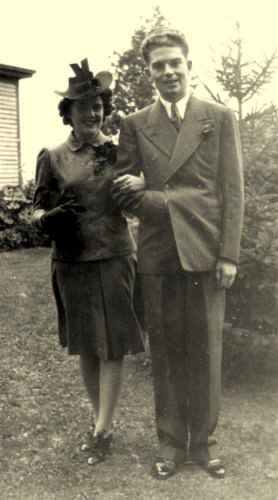
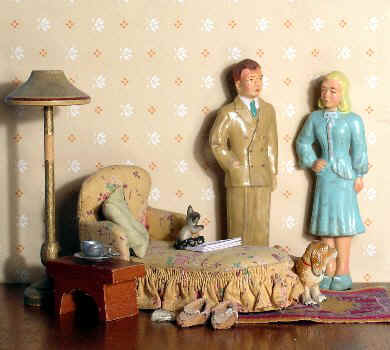
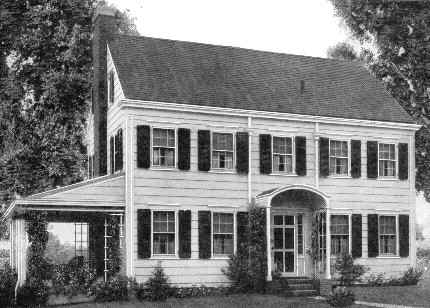 left:
from a pattern book for real houses of 1928 (O'Dell) and below a frame house in Kingston,
Ontario, Canada, from the 1940s with shutters ornamented by a pine tree cut-out, as is
found in American contemporary dollhouses by Rich (illustrated further below) photo, J.McKendryİ
left:
from a pattern book for real houses of 1928 (O'Dell) and below a frame house in Kingston,
Ontario, Canada, from the 1940s with shutters ornamented by a pine tree cut-out, as is
found in American contemporary dollhouses by Rich (illustrated further below) photo, J.McKendryİ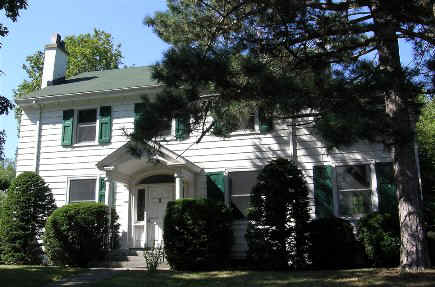
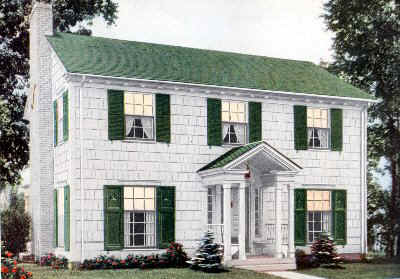 left: a
real house from O'Dell's book of 1928 illustrating a popular colour scheme of white siding
with green shutters and roof and below a house in Kingston from the 1940s; note the small
window over the main doorway as found in some dollhouses of the period photo, J.McKendryİ
left: a
real house from O'Dell's book of 1928 illustrating a popular colour scheme of white siding
with green shutters and roof and below a house in Kingston from the 1940s; note the small
window over the main doorway as found in some dollhouses of the period photo, J.McKendryİ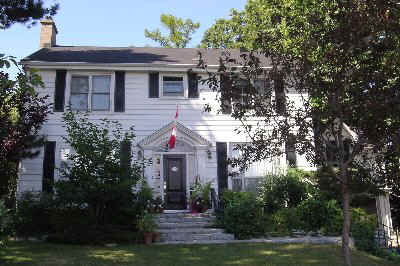
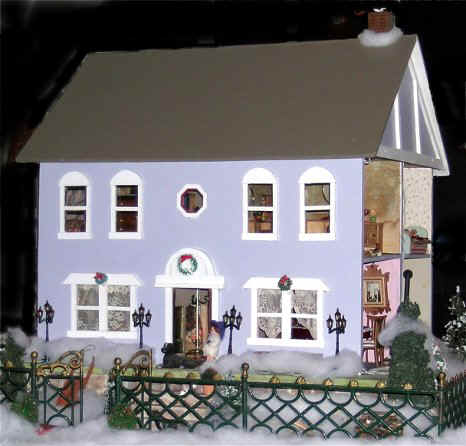
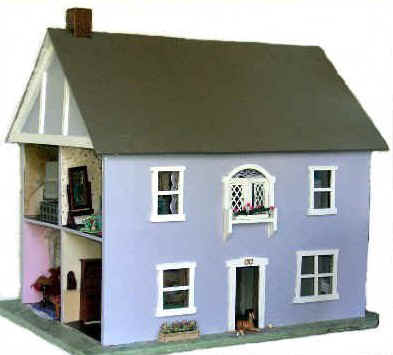
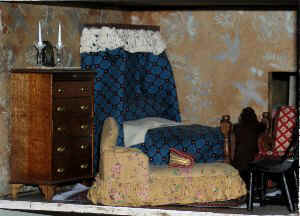
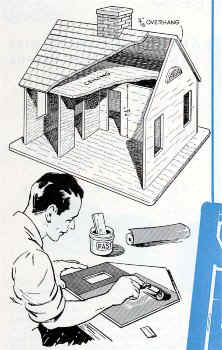
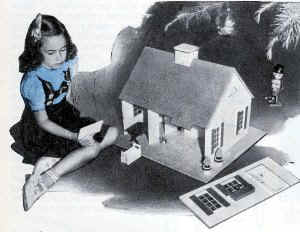
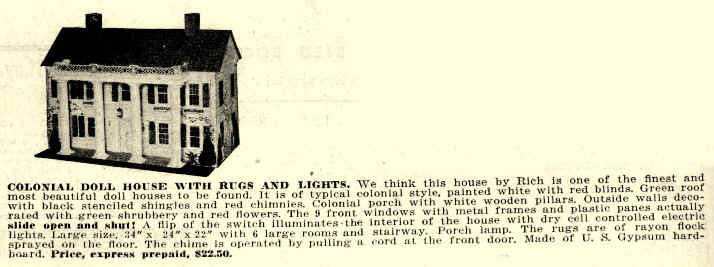

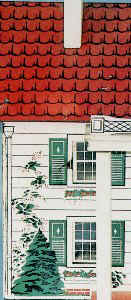
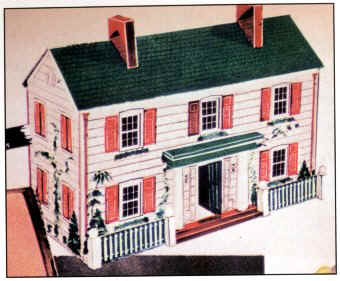
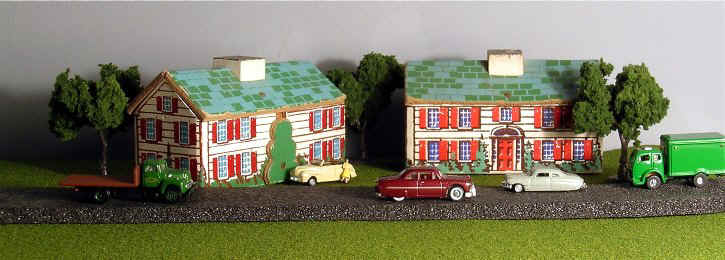
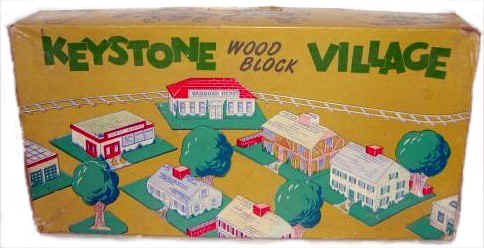 One of their main competitors was KEYSTONE of
Boston, active in manufacturing dollhouses from the mid 1930s to about 1953. Their
masonite dollhouses were decorated more fully in the interior than the Rich houses, which
isolated ornament to the floors.
One of their main competitors was KEYSTONE of
Boston, active in manufacturing dollhouses from the mid 1930s to about 1953. Their
masonite dollhouses were decorated more fully in the interior than the Rich houses, which
isolated ornament to the floors. 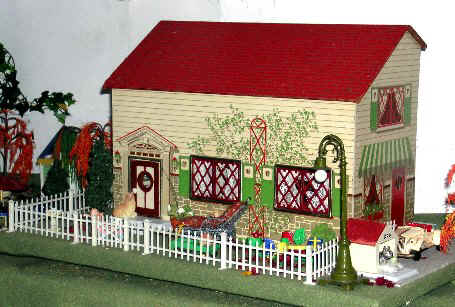
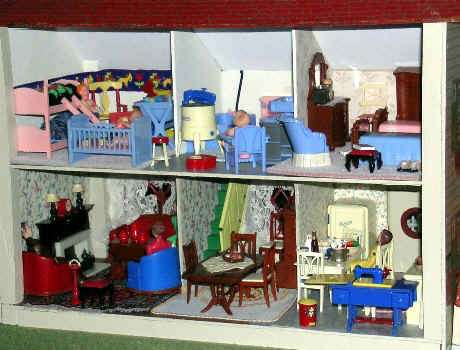
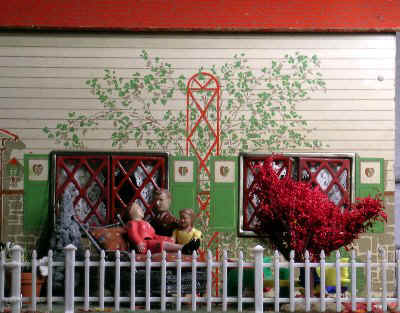 Because the masonite used in this house is stamped "Made in Canada", it
is tempting to think it was made by some as yet unidentified Canadian company, likely
struggling for survival against the market domination of American toy companies. The
interior was completely unfinished but has recently had paint and wall paper added.
Retrofitting wallpaper is a stressful task! The tin staircase is old but did not come with
the house. The metal lattice-work windows swing open in the front wall but are printed
imitations on the end walls. The front door is a replacement (it opens while the side door
under the striped awning is a printed imitation). Although lacking the symmetry and
central axis of most Colonial houses, the doorway detailing is convincingly Classical.
Particularly appealing is the red trellis and vines behind the green and white shutters
with their cut-out hearts. photo, J.McKendryİ
Because the masonite used in this house is stamped "Made in Canada", it
is tempting to think it was made by some as yet unidentified Canadian company, likely
struggling for survival against the market domination of American toy companies. The
interior was completely unfinished but has recently had paint and wall paper added.
Retrofitting wallpaper is a stressful task! The tin staircase is old but did not come with
the house. The metal lattice-work windows swing open in the front wall but are printed
imitations on the end walls. The front door is a replacement (it opens while the side door
under the striped awning is a printed imitation). Although lacking the symmetry and
central axis of most Colonial houses, the doorway detailing is convincingly Classical.
Particularly appealing is the red trellis and vines behind the green and white shutters
with their cut-out hearts. photo, J.McKendryİ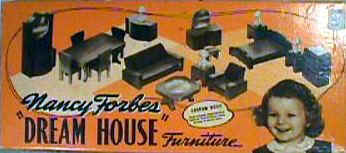 NANCY FORBES
(Rapaport Bros.) of Chicago featured solid walnut furniture with metal knobs in the
streamlined design that had evolved out of the 1930s Art Deco. Rounded shoulders on
bureaus contrasted with the angled effect of the octagonal mirrors on certain bedroom
pieces. The warmth of the metal knobs and natural wood was appealing but the austerity of
the white kitchen set (shown further below below in original box, c1945) with only
incising representing knobs and handles left something to the imagination -- luckily an
aspect children could provide.
NANCY FORBES
(Rapaport Bros.) of Chicago featured solid walnut furniture with metal knobs in the
streamlined design that had evolved out of the 1930s Art Deco. Rounded shoulders on
bureaus contrasted with the angled effect of the octagonal mirrors on certain bedroom
pieces. The warmth of the metal knobs and natural wood was appealing but the austerity of
the white kitchen set (shown further below below in original box, c1945) with only
incising representing knobs and handles left something to the imagination -- luckily an
aspect children could provide.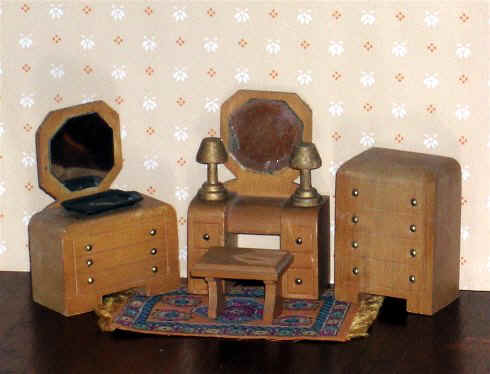
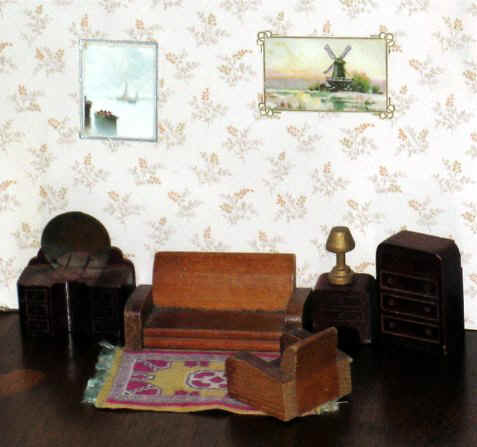
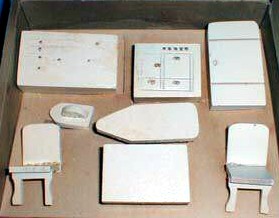

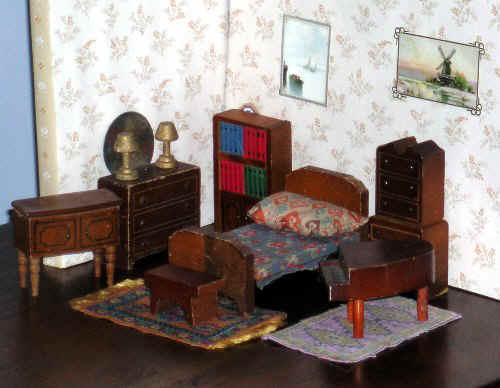 The
KAGE Company of Manchester,
Connecticut, produced upholstered and wood furniture from 1938 to 1948. Once they switched
from dowel legs (see piano) to turned ones (see buffet), the attractive nature of many of
their pieces increased. They were, however, simplistic forms even when attempting
ambitious case pieces such as the chest-on-chest (on the right of the bed). A broken
pediment becomes a thick cut-out. Ornament may be indicated by painted detailing, as in
the panels on the buffet doors. The kitchen pieces are more engaging (below) -- a butcher
block on turned legs with reeded sides and a sink with a metal faucet and supported on a
pair of metal U legs. This is the last hurrah of the kitchen sink on legs -- in this
decade being replaced by built-in sinks with lower cupboards in the manner we still favour
today.
The
KAGE Company of Manchester,
Connecticut, produced upholstered and wood furniture from 1938 to 1948. Once they switched
from dowel legs (see piano) to turned ones (see buffet), the attractive nature of many of
their pieces increased. They were, however, simplistic forms even when attempting
ambitious case pieces such as the chest-on-chest (on the right of the bed). A broken
pediment becomes a thick cut-out. Ornament may be indicated by painted detailing, as in
the panels on the buffet doors. The kitchen pieces are more engaging (below) -- a butcher
block on turned legs with reeded sides and a sink with a metal faucet and supported on a
pair of metal U legs. This is the last hurrah of the kitchen sink on legs -- in this
decade being replaced by built-in sinks with lower cupboards in the manner we still favour
today.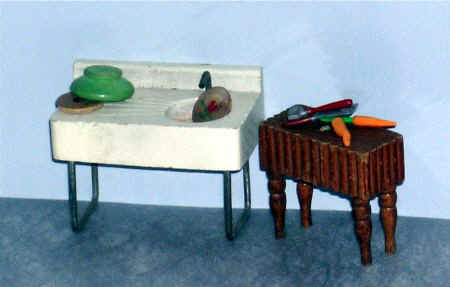 photo, J.McKendryİ
photo, J.McKendryİ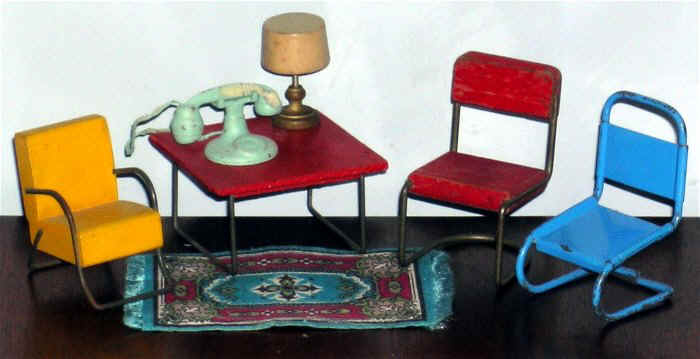
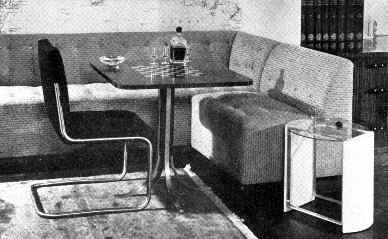
 where so many modern
ideas rocked the worlds of design and architecture. The red metal-and-wood and blue metal
chairs (above) are cantilevered, while the remaining dollhouse pieces have U
shaped leg supports, echoing other real furniture from the1920s.The black and white
photographs are from Furniture and Decoration Period and Modern by Joseph
Aronson, 1936 with revisions 1941.
where so many modern
ideas rocked the worlds of design and architecture. The red metal-and-wood and blue metal
chairs (above) are cantilevered, while the remaining dollhouse pieces have U
shaped leg supports, echoing other real furniture from the1920s.The black and white
photographs are from Furniture and Decoration Period and Modern by Joseph
Aronson, 1936 with revisions 1941.